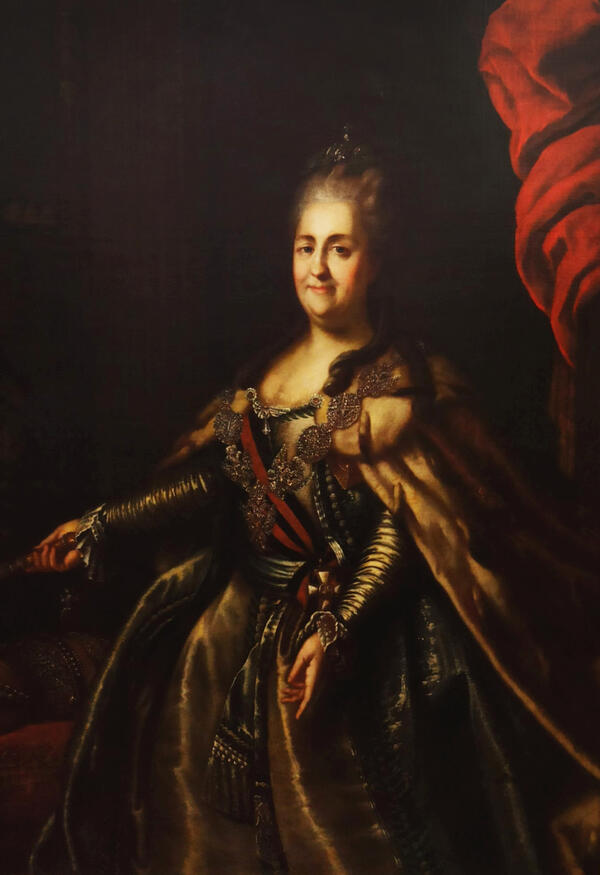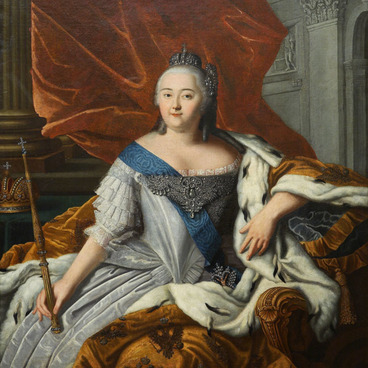Один из самых интересных портретов Екатерины Великой принадлежит кисти шведского художника Александра Рослина (15 июля 1718 г., Мальмё — 5 июля 1793 г., Париж). Он был исполнен в 1776–77 годах, в Петербурге, но не пришелся по вкусу императрице. Образы шведа всегда отличались реалистичностью, и художник правдиво, без лести и угодничества изобразил стареющую Екатерину. Она не могла принять такую правду от иностранного художника, к тому же привыкла видеть себя на портретах и моложе, и привлекательнее.
‘Исправить’ неугодный портрет императрица поручила прославленному русскому живописцу Фёдору Степановичу Рокотову (1735 г., имение Воронцово — 24 декабря 1808 г., Москва). Переписал Рокотов только лицо, внес незначительные коррективы в фасон платья, сохранив при этом и композицию, и пышную обстановку портрета Рослина. Рокотов не только смягчил черты лица императрицы, сделав их правильнее и приятнее, но и придал выражению ту величественную одухотворенность, которую так настойчиво демонстрировала Екатерина II перед своими подданными. Прическа императрицы стала более высокой и пышной. Ее голова увенчана короной и лавровым венком. Декольте платья сделано более глубоким и открытым. Екатерина II осталась очень довольна работой мастера и самолично приказала следовать Рослину только в композиции, а лицо писать ‘по Рокотову’ при изготовлении других экземпляров. Так появился знаменитый совмещенный тип Рослина — Рокотова.
Неизвестный художник ХVIII века использовал упомянутый тип при написании таганрогского портрета. Он представил Екатерину поколенно, в платье серебристой парчи и лиловом казакине, с горностаевой мантией на плечах. Освещенная фигура императрицы выступает из темноты фона, в котором едва просматриваются и необходимые для парадного портрета атрибуты — скипетр, держава и большая императорская корона. На заднем плане художник изобразил колонну с пурпурной портьерой. Он намеренно погружает в темноту весь антураж парадного изображения. Главной становится фигура самой императрицы, а основное внимание зрителя привлекает именно ее лицо, проницательный взгляд и легкая улыбка.
One of the most interesting portraits of Catherine the Great belongs to the Swedish artist Alexander Roslin (July 15, 1718, Malmo - July 5, 1793, Paris). It was created in 1776–1777, in Saint Petersburg, but the empress did not like it. The images of the artist always were distinguished by their realism. He truly, without flattery and servility, portrayed the aging Catherine. She could not accept such a truth from a foreign artist, moreover, she was used to seeing herself in portraits both younger and more attractive.
The Empress entrusted the famous Russian painter Fyodor Rokotov (1735, Vorontsovo estate - December 24, 1808, Moscow) to ‘fix’ the unwanted portrait. Rokotov repainted only the face and made minor adjustments to the style of the dress, while retaining both the composition and the magnificent setting of Roslin’s portrait. Rokotov not only softened the empress’s facial features, making them more correct and more pleasant, but also gave the expression that majestic spirituality that Catherine II so persistently demonstrated in front of her subjects. The Empress’s hairstyle became taller and more luxuriant. Her head is adorned with a crown and a laurel wreath. The neckline of the dress is made deeper and more open. Catherine II was very pleased with the work of the master and personally ordered to follow Roslin only in composition, and to paint her face “according to Rokotov” when making other copies. This is how the famous combined type of Roslin and Rokotov appeared.
An unknown artist of the 18th century used the mentioned type when painting a Taganrog portrait. He introduced Catherine in a dress of silvery brocade and a lilac casaquin, with an ermine mantle on his shoulders. The illuminated figure of the empress emerges from the darkness of the background, in which the attributes necessary for a ceremonial portrait like a scepter, an orb and a large imperial crown are barely visible. In the background, the artist depicted a column with a purple curtain. He deliberately plunges the entire entourage of the ceremonial image into darkness. The main figure becomes the empress herself, and the main attention of the viewer is attracted by her face, penetrating eyes and a slight smile.
‘Исправить’ неугодный портрет императрица поручила прославленному русскому живописцу Фёдору Степановичу Рокотову (1735 г., имение Воронцово — 24 декабря 1808 г., Москва). Переписал Рокотов только лицо, внес незначительные коррективы в фасон платья, сохранив при этом и композицию, и пышную обстановку портрета Рослина. Рокотов не только смягчил черты лица императрицы, сделав их правильнее и приятнее, но и придал выражению ту величественную одухотворенность, которую так настойчиво демонстрировала Екатерина II перед своими подданными. Прическа императрицы стала более высокой и пышной. Ее голова увенчана короной и лавровым венком. Декольте платья сделано более глубоким и открытым. Екатерина II осталась очень довольна работой мастера и самолично приказала следовать Рослину только в композиции, а лицо писать ‘по Рокотову’ при изготовлении других экземпляров. Так появился знаменитый совмещенный тип Рослина — Рокотова.
Неизвестный художник ХVIII века использовал упомянутый тип при написании таганрогского портрета. Он представил Екатерину поколенно, в платье серебристой парчи и лиловом казакине, с горностаевой мантией на плечах. Освещенная фигура императрицы выступает из темноты фона, в котором едва просматриваются и необходимые для парадного портрета атрибуты — скипетр, держава и большая императорская корона. На заднем плане художник изобразил колонну с пурпурной портьерой. Он намеренно погружает в темноту весь антураж парадного изображения. Главной становится фигура самой императрицы, а основное внимание зрителя привлекает именно ее лицо, проницательный взгляд и легкая улыбка.
One of the most interesting portraits of Catherine the Great belongs to the Swedish artist Alexander Roslin (July 15, 1718, Malmo - July 5, 1793, Paris). It was created in 1776–1777, in Saint Petersburg, but the empress did not like it. The images of the artist always were distinguished by their realism. He truly, without flattery and servility, portrayed the aging Catherine. She could not accept such a truth from a foreign artist, moreover, she was used to seeing herself in portraits both younger and more attractive.
The Empress entrusted the famous Russian painter Fyodor Rokotov (1735, Vorontsovo estate - December 24, 1808, Moscow) to ‘fix’ the unwanted portrait. Rokotov repainted only the face and made minor adjustments to the style of the dress, while retaining both the composition and the magnificent setting of Roslin’s portrait. Rokotov not only softened the empress’s facial features, making them more correct and more pleasant, but also gave the expression that majestic spirituality that Catherine II so persistently demonstrated in front of her subjects. The Empress’s hairstyle became taller and more luxuriant. Her head is adorned with a crown and a laurel wreath. The neckline of the dress is made deeper and more open. Catherine II was very pleased with the work of the master and personally ordered to follow Roslin only in composition, and to paint her face “according to Rokotov” when making other copies. This is how the famous combined type of Roslin and Rokotov appeared.
An unknown artist of the 18th century used the mentioned type when painting a Taganrog portrait. He introduced Catherine in a dress of silvery brocade and a lilac casaquin, with an ermine mantle on his shoulders. The illuminated figure of the empress emerges from the darkness of the background, in which the attributes necessary for a ceremonial portrait like a scepter, an orb and a large imperial crown are barely visible. In the background, the artist depicted a column with a purple curtain. He deliberately plunges the entire entourage of the ceremonial image into darkness. The main figure becomes the empress herself, and the main attention of the viewer is attracted by her face, penetrating eyes and a slight smile.



